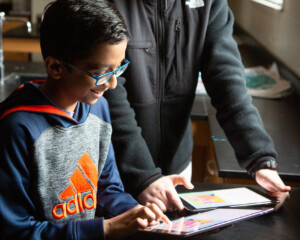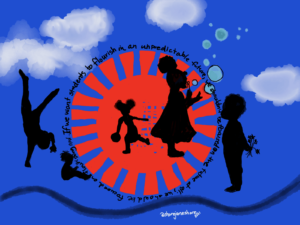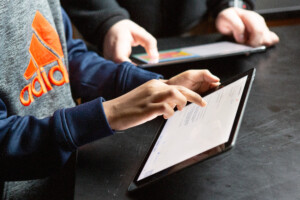8 Examples of the Future of EdTech, Fresh from FETC

Heralding the need for a revolution in education, Sir Ken Robinson was the keynote speaker that kicked off the 39th annual Future of Education Technology Conference (FETC) in Orlando, FL. Robinson, a renowned educational leader and speaker, blended advocacy for locally-designed, open-ended student learning with criticism of the over-emphasis of standardization in US educational policy and practice. He noted that contemporary US methods rely on outputs such as achievement, attendance, and discipline as measures of success and perceptions of quality. The labels of school grades and rankings are emphasizing the wrong attributes and reinforcing wasteful decision patterns.
He likened this to the mechanized US farming system, where practices are focused on outputs like a standard size and shape for each fruit or grain. Crops with uniform appearance are prioritized over those with a higher nutritional value or greater sustainability for the future. In contrast, organic farmers have realized that, in order to maximize production, nutrition, and consistency across harvest seasons, they must focus on the soil and environment instead of the outcome. Each plant, fruit, or vegetable will look a little different, but the quality far surpasses traditional crops. Foods that are output in a standardized manner, but lack nutritional quality, will not keep a body healthy no matter how well-labeled. The same is true for our schools.
Robinson clearly stated that the emphasis on standardization in education is even more harmful to students than mechanized farming is to crop quality. Education systems need to replace practices of “conformity, compliance, and competition” with “diversity, creativity, and collaboration.” To yield engagement, achievement, and 21st-century skills, educational systems must turn constraints and structures from ends in themselves to ladders for progress and human development.
Robinson threw down the gauntlet to the educators in the room, insisting that they utilize technology in classrooms as a tool to create these kinds of engaging and dynamic learning experiences for all students. Throughout the sessions and expo hall at FETC, educators and vendors, alike, showed that they are already heeding this call, creating opportunities for students across the PK-12 spectrum to create, explore, collaborate, and problem solve.
So, what EdTech tools and resources did I see on the expo floor and in the session rooms that would help create the school culture envisioned by Sir Ken? Here are some that stood out:
Virtual Reality
- Zspace – Whether the PC, video games, or now virtual reality, so much of the history of new technologies begins with an individual user. The turn from productivity to creativity, and the explosion of usage leading to significant societal impact, comes with interactivity and open-ended usage. Z-space is a mixed reality learning ecosystem. Hardware, software, and content integration provide student-driven inquiry, risk-taking and collaboration. It is very cool to experience what I have always thought of as future-only educational tools.
- Storyfab – Students love to use figures to do open-ended play and storytelling. Carrying the spirit of storytelling into augmented reality this tool allows students to be producer, director and distributor of their own stories. Not only is “all the world a stage”, but so are all social media platforms, and this app would make Shakespeare smile.
- Nearpod – Provides students and educators with the opportunity to create, curate and procure interactive, 3-D, group-enabled experiences. Amazing ability to connect materials of many different digital types, this tool is estimated to already be in use in 10% of classrooms in the US. Slideshows will be soon be relegated to the history of 20th Century education.
Making and Creation
- MakerBot 3-D Printing – Getting those crazy ideas out of students’ heads and into their hands has been a desire of teachers since even before thinkers like Plato. And 3-D printing is making it happen. This manufacturer has gone well beyond ensuring reliability and ease of set-up by having a library of lesson plans and a community of users. Families will free up space on their refrigerator as worksheets marked with grades are replaced by knick-knacks on the counter.
- Bloxels – Designing video games requires considering narrative, coding, characters, and physics. This toolset structures all of those responsibilities in a manner that is easy for teachers to explain and students to commence creating and sharing games. And since video games can be used to explore history, literature, math, science, and any other explainable topic, it is a natural fit in any classroom.
- littleBits – If learning is to have students be able to construct new things given their knowledge and concepts, then one way to make that clear to them is to treat them as inventors. This kit-based (with supplementary components) system provides the components to have students be designers, engineers, and documentation providers with and for each other. Snapping things together has never been so purposeful.
Building AND Programming
- Piper – While Dungeon & Dragons, Pokemon, and other games that have consumed young learners outside of school time, they have not been able to penetrate schools beyond after-school clubs. Minecraft is proving to be different. And that success has inspired a product that combines electronics and programming learning by utilizing Minecraft’s version of Raspberry Pi. Creativity and mental discipline being developed at the hardware, software, and entertainment architecture level in an age agnostic manner – this is rigorous learning at its best.
- Pi-top – Going beyond the spirit of having students have to be responsible for their own laptop now means having students build, program, and create their own devices. Cost effective, rewarding of creativity in real-time and able to scale for group projects, this platform now supports students building either a desktop or a laptop. And like Piper above, Pi-top utilizes the Raspberry Pi as its core component.
The ubiquitous presence of the Google suite of products as a platform for utilizing many tools was notable throughout the conference. Significant adoption of chromebooks by districts (both large and small) was also evident, as sessions on Google-integrated classrooms overflowed with participants. There was a great deal of interest by conference attendees in finding ways to utilize the Google tools to promote collaboration and creation in their classrooms, and to manage learning.
The Future of Education Technology
The enthusiasm and passion of the presenters, vendors, and most importantly, the educators at FETC 2018 made the future of education technology look very bright. Teachers are excited by the seemingly limitless possibilities different EdTech tools provide to extend the walls of their classrooms, to allow their students to use agency and voice to show and extend learning, and to build their own new EdTech tools to fill current voids. The market is truly robust, with new devices, apps, and even completely new technologies entering the fold on a daily basis. And students are eager to bring the creativity, collaboration, and flexibility of their social and home lives to their learning. As we look to the future of education technology, will districts, administrators, and communities have the bravery to buck the current norm of standardization and unleash the potential of our teachers and students? Sir Ken Robinson certainly believes that this is the key to success in the future.
For more, see:
- 10 New and Innovative EdTech Products Announced at ISTE 2017
- How and Where EdTech Will Help
- 12 Digital Tools to Try in 2018
Stay in-the-know with all things EdTech and innovations in learning by signing up to receive the weekly Smart Update.








0 Comments
Leave a Comment
Your email address will not be published. All fields are required.